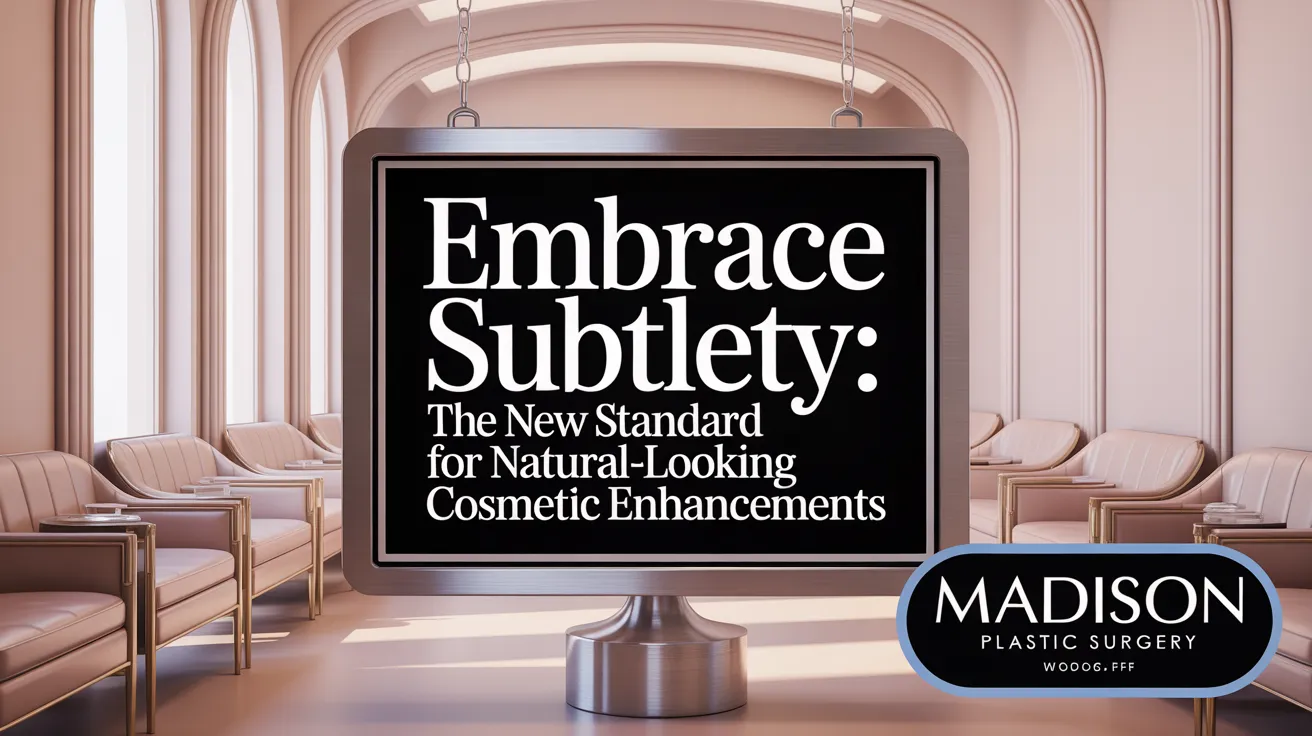The Art and Science Behind Natural-Looking Plastic Surgery
In the evolving field of plastic surgery, the quest for natural-looking results has become paramount. Precision—not just in technique but in personalized planning and execution—is reshaping patient experiences and outcomes, enabling enhancements that maintain individuality and subtlety. This article explores how meticulous detail, advanced technology, and artistic sensibility coalesce to achieve the seamless, authentic improvements patients desire today.
Precision: The Cornerstone of Natural Refinement in Plastic Surgery

Why is precision critical in achieving natural-looking results in plastic surgery?
Precision in plastic surgery is fundamental to maintaining the unique characteristics of a patient's face or body. It requires a deep understanding of anatomy combined with an artistic sensibility to ensure that enhancements appear subtle and harmonious. This careful balance prevents unnatural or exaggerated outcomes and preserves the natural proportions and symmetry that define an individual's appearance. For more insight, see Natural-looking results in plastic surgery and Precision in Facial Plastic Surgery.
Precise surgical techniques involve accurate incisions, targeted fat removal or transfer, and refined tissue repositioning. These meticulous methods help produce seamless results that integrate naturally with the patient's existing features, avoiding obvious signs of surgery. Additional details can be found in Operating principles for plastic surgeons and High-definition liposuction benefits.
How do surgeon qualifications and personalized planning contribute to natural outcomes?
Choosing a board-certified plastic surgeon with extensive experience is crucial for achieving natural-looking results. Such surgeons possess advanced skills in both the science and art of cosmetic procedures, allowing them to tailor techniques to the unique anatomy and aesthetic goals of each patient.
Personalized treatment planning begins with thorough consultations, where surgeons listen carefully and set realistic expectations. These meetings enable customization of the surgical approach, ensuring that outcomes align with the patient's vision while maintaining safety and balance. More on personalized planning is available in Personalized treatment strategies in plastic surgery and Consultations for natural outcomes.
Surgeons employ advanced tools like 3D imaging and fat grafting to enhance precision further. This personalized and evidence-based approach maximizes patient satisfaction by fostering natural, refined enhancements rather than dramatic changes that look artificial. See also Evidence-Based Clinical Practice Guidelines and The Art of Subtle Results.
Technological Advances Enhancing Surgical Precision and Outcomes

What technological innovations support precision in plastic surgery?
Modern plastic surgery greatly benefits from advanced technological tools that enhance precision and improve patient outcomes. Among these, three-dimensional (3D) imaging systems such as stereophotogrammetry and Vectra 3D devices provide surgeons with detailed and repeatable facial and body analyses. These technologies allow for accurate measurement of symmetry, soft tissue volume, and morphology, aiding in meticulous surgical planning.
Augmented reality (AR) is also emerging as a valuable tool, enabling surgeons to visualize anatomy and surgical outcomes more realistically before performing procedures. This technology supports enhanced customization and patient communication.
In body contouring, ultrasound-assisted liposuction, particularly VASER liposuction, uses ultrasonic energy to liquefy fat cells selectively, preserving surrounding tissues. This method facilitates high-definition liposuction, which sculpts athletic and defined body contours by emphasizing underlying muscle structures with minimal invasiveness and shorter recovery times.
Regenerative techniques such as fat grafting utilize a patient's own fat tissue to restore volume naturally and improve skin quality. Fat grafting promotes tissue regeneration through stem cells and is often combined with surgical and non-surgical procedures to achieve long-lasting, natural-looking results.
Minimally invasive procedures—including neurotoxin injections, dermal fillers, laser skin resurfacing, and microneedling—complement surgical approaches by providing subtle enhancements and swift recovery with less risk.
Technological innovations continue to transform plastic surgery by enabling precise, personalized treatments that maintain natural aesthetics and improve patient satisfaction.
The Shift Towards Subtle and Natural Enhancements in Aesthetic Surgery

What are the current trends in plastic surgery regarding natural-looking results?
Contemporary plastic surgery trends emphasize achieving natural-looking results in plastic surgery through subtle, personalized enhancements. Patients increasingly prefer outcomes that maintain their unique features, favoring a refreshed and youthful appearance over dramatic transformations.
Trends favoring subtlety over dramatic changes
Modern aesthetic preferences have shifted toward balance and harmony, moving away from exaggerated or overly enhanced looks. This trend prioritizes understated elegance in surgery and realistic improvements that preserve individual anatomical characteristics.
Use of fat transfer and smaller implants
Fat transfer technique has gained popularity for restoring youthful volume in the face and for modest breast enhancements, utilizing the patient’s own tissue to achieve organic, natural shapes. Smaller, anatomically shaped breast implants are favored over larger sizes, providing natural breast proportions with fewer long-term risks.
Conservative approaches to facial rejuvenation
Facial rejuvenation now involves more conservative methods, such as deep plane facelifts that reposition deeper tissues rather than simply stretching skin. This approach helps maintain natural facial expressions and avoids the 'overdone' appearance common with older techniques. The use of precise injectables, including Botox and dermal fillers administered in small, carefully calibrated doses, enhances volume subtly while preserving facial movement.
Combination of surgical and non-surgical treatments
Personalized treatment plans often combine surgical procedures with non-invasive options like laser therapy, chemical peels, and microneedling. This holistic approach allows comprehensive cosmetic treatments while minimizing downtime and maintaining natural aesthetics.
Societal and cultural influences
Social media and cultural movements promote authenticity and self-identity, encouraging patients to seek enhancements that complement rather than change their natural look. The trend is propelled by the desire for timeless appearance in cosmetic surgery that enhance confidence without compromising individuality.
Plastic surgeons now integrate advanced technologies such as 3D imaging and refined incision placement to align surgical outcomes with these modern preferences, ensuring seamless, natural results that blend effortlessly with each patient's distinct features.
Precision in Facial Plastic Surgery: Balancing Function and Aesthetics

How does precision impact facial plastic surgery outcomes?
Facial plastic surgery demands extraordinary precision to ensure results that maintain facial symmetry and preserve natural features. Precision allows surgeons to enhance a patient’s appearance while avoiding visible signs of surgical intervention. For instance, deep plane facelifts involve repositioning deeper tissue layers rather than merely stretching skin, which maintains natural tension lines and prevents an unnatural "pulled" look (Natural-Looking Plastic Surgery Trends in 2025).
Techniques in Facelift, Rhinoplasty, and Blepharoplasty
Each procedure requires meticulous attention to anatomy. Facelifts are now performed with refined methods focusing on tissue repositioning for long-lasting, naturally youthful contours. Rhinoplasty respects ethnic facial traits and overall balance, aiming to harmonize rather than dramatically alter (natural-looking results in rhinoplasty). Blepharoplasty uses a conservative approach to preserve eyelid contours and natural, rested appearances without hollowing (Reduction Mammaplasty Revision Guidelines 2022).
Importance of Natural Facial Expressions
A critical measure of success is how surgery affects facial expressions. Precise surgeries avoid overstretched or frozen appearances, preserving skin elasticity and muscle function. This subtlety ensures patients retain their unique expressions, enhancing authenticity and psychological well-being (Natural-Looking Plastic Surgery).
Applications of Regenerative Medicine
Innovations such as fat grafting not only restore volume but also promote skin rejuvenation through stem cell activity. These regenerative therapies complement surgical work by softly enhancing contours, contributing to natural and durable outcomes (Natural-Looking Enhancements).
Patient-Centered Care and Emotional Well-being
The precision in surgery extends to personalized care, where surgeons develop tailored plans aligned with individual anatomy and goals. Addressing emotional well-being alongside physical outcomes ensures a positive overall experience and patient satisfaction (Mastering Precision in Plastic Surgery Reversals).
In sum, precision in facial plastic surgery integrates anatomical knowledge, artistic skill, and advanced regenerative techniques to produce results that respect natural beauty and functionality, prioritizing the patient’s unique features and emotional health (Precision in Facial Plastic Surgery).
Safety, Recovery, and Long-Term Success Through Precision Practices

Why are safety and postoperative care integral to achieving natural and lasting results?
Safety in plastic surgery begins with choosing accredited surgical facilities that adhere to strict national standards for equipment, hygiene, personnel, and American Board of Plastic Surgery certification. These environments implement protocols such as sterilization, infection control, certified anesthesia monitoring, and emergency preparedness to minimize risks of complications.
Preoperative planning is a cornerstone of successful outcomes. Surgeons conduct thorough patient evaluations to tailor treatment plans that align with individual anatomy and goals. Detailed patient education about the procedure, potential risks, and realistic expectations ensures informed consent and a cooperative recovery process.
Postoperative care plays a vital role in healing and result longevity. Proper rest, avoiding blood thinners, healthy nutrition, and following precise surgeon instructions help reduce swelling, bruising, and risk of infection. Scheduled follow-up appointments enable early detection and management of any issues, promoting optimal recovery.
Board certification by recognized entities, such as the American Board of Plastic Surgery certification, signifies a surgeon’s maintained expertise and adherence to ethical standards. Such ethical practice prioritizes patient safety and well-being above all, fostering trust and improving psychological outcomes for patients.
Together, these precision practices not only enhance physical results but also contribute to patient confidence, satisfaction, and emotional well-being, fulfilling the holistic goals of modern plastic surgery.
Precision: The Foundation of Authentic Beauty in Plastic Surgery
Precision in plastic surgery represents the fusion of art, science, and technology tailored to the individual. It enables surgeons to deliver subtle enhancements that honor the patient’s natural features, ensuring outcomes that are both aesthetically pleasing and authentic. Advances in imaging, surgical techniques, and regenerative medicine have elevated the surgeon's ability to plan and execute with remarkable accuracy. Equally important are comprehensive safety protocols and personalized patient care that support recovery and sustain results. As the field evolves, embracing precision remains the key to achieving natural-looking plastic surgery results that inspire confidence and celebrate individuality.
